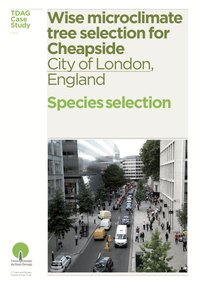| In the centre of the City of London, between St Paul’s and Bank, the Cheapside area is undergoing a dramatic transformation. Since 2010, a series of major new developments have more than doubled the amount of retail floor space. The equivalent of a significant shopping mall is being created
in a high street location, primarily along Cheapside itself. In response, the City of London Corporation launched a streetscape improvement programme aimed at rebalancing the relationship between pedestrians and vehicles, creating a safer and more inclusive environment while maintaining the current traffic capacity. Traffic lanes have been narrowed to four metres and footways widened by an average of three metres. |
| Unnecessary street furniture has been removed and dedicated loading bays have been created to service the shops without interfering with bicycle or vehicular traffic. The scheme also features one tree replacement and the planting of 19 new trees – helping to calm traffic, enhance the pedestrian environment and alleviate the urban heat island effect prevalent in such
an inner city setting. The positioning of the trees was carefully considered in relation to the extensive amount of underground utilities found in the area. Collaboration with the utility providers meant that some cables, including fibre optics, could be moved about a foot along the street. Without this, the planting would not have been possible. The most challenging negotiation for the client team related to tree selection. The planning and urban design leads were keen to plant avenue-style, with a single species. Their open space and arboriculture colleagues pointed out that very different conditions were found on either side of this east-west street: the northern footway being very hot due to sun exposure and intense reflection from the south facing (often glass) façades, and the southern side lying mostly in the shade. The team further observed that, while Cheapside is a historic street, it had lost its historic building frontage and is now lined with mixture of unevenly set buildings. While a strong line of trees would help to hold together what could have otherwise been a disjointed frontage, the eclectic nature of its development didn’t require a planting style reminiscent of the past. The design approach therefore prioritised a linear planting arrangement and adaptation to microclimate over the creation of a unified avenue effect. The shady side of the street is planted with alder trees (Alnus x spaethii) while the opposite, sunnier and hotter footway has American sweet gums (Liquidambar orientalis). Counts conducted before (2006) and after (2013) the schemes have shown that the objectives that had been set for the streetscape improvements have been fully achieved: pedestrian footfall has increased by 50%, bicycle traffic has risen by over 200%, while motorised traffic has remained stable. Seven years on following the project completion, the trees on both sides of the street are thriving. |
| Project team: | City of London Corporation (client). Designed and managed in-house through the Transportation and Public Realm Division (of the Department of the Built Environment), with planting by the City Gardens team (of the Open Spaces Department). |
| Project completion: | December 2011 |
| Further information: | n.a. |
| Download: |
| ||
| Version: | This case study was originally published in Trees in Hard Landscapes: A Guide for Delivery (2014). The updated version 1.1 above was released in February 2018. |
| Author(s): | This case study was drafted by Anne Jaluzot, based on interviews and/or input from Patrick Hegarty (Technical Manager, Open Space, City of London Corporation), Bradley Viljoen (Project Officer, Open Space, City of London Corporation) and Sam Lee (Team Leader, Built Environment, City of London Corporation) |


 RSS Feed
RSS Feed